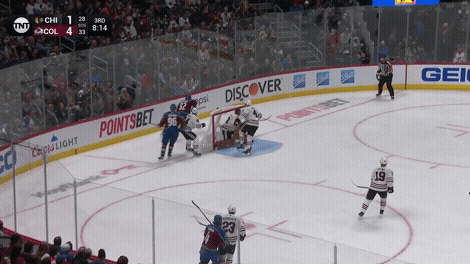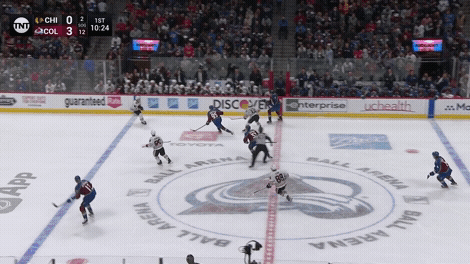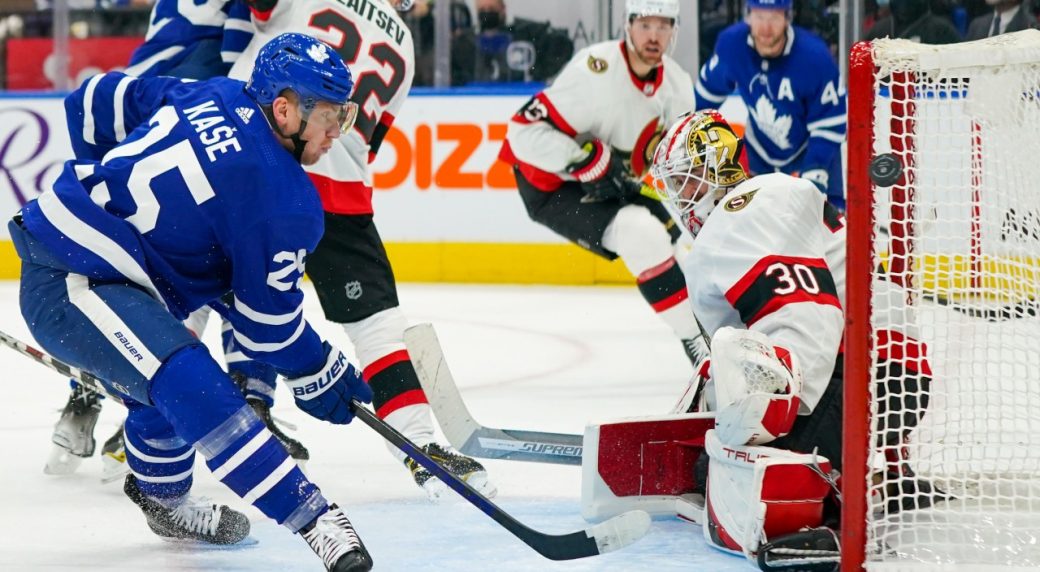Every Friday this season we'll highlight the performance of four players and the timely storylines that surround them. There will be Olympic ramifications to some of these, or how they're impacting teams on the rise or fall.
Our first Friday Four focuses on Ondrej Kase's intriguing start in Toronto, Seth Jones' worrisome first game with the Blackhawks, Drew Doughty's bid for Team Canada, and Alex Ovechkin vs. Father Time as he chases down Wayne Gretzky.
It's Week 1, so it's too early to make any grand conclusion about how anyone will fare this season. But these players could be important for various reasons, so seeing how they trend will be important as the year goes along.
(all stats per the wonderful Natural Stat Trick)
ONDREJ KASE, TORONTO MAPLE LEAFS
The Toronto Maple Leafs spent the summer at the bargain bin, searching for affordable talent to surround their big-money stars with.
Michael Bunting is a 26-year-old breakout candidate after we saw him put up 10 goals in a 21-game "rookie" season with the Arizona Coyotes in 2020-21. Bunting has played so few games that he's actually still a rookie now and potential Calder candidate.
Nick Ritchie has much more of a track record, with six NHL seasons under his belt. He'll turn 26 in December and starts with the cushy spot on Line 1 with Mitch Marner and (for now) John Tavares. Auston Matthews will slide in there when he returns. Ritchie is the seemingly perfect big-body complement to those two who will replace Zach Hyman's sandpaper and, perhaps, has 20-goal upside (he scored 15 times in 56 games with the Bruins last season).
But it's Ondrej Kase who could possibly have the greatest upside here.
Turning 26 next month, Kase has been around as long as Ritchie, and flashed the same breakout potential (or more) as Bunting. In Kase's first three years in the league, he wasn't getting top-line minutes with the Anaheim Ducks, but his 5-on-5 goal production indicated the potential to be an impact player with an expanded role.
| YEAR | Average even strength TOI/Game | Goals/60 mins at 5-on-5 |
|---|---|---|
| 2016-17 | 11:33 | 0.4 |
| 2017-18 | 12:36 | 1.28 |
| 2018-19 | 13:26 | 1.56 |
In 2019-20, the Boston Bruins recognized this potential and evaluated it was worth spending a first-round pick on to acquire at the trade deadline. Kase played six games for them until the pandemic forced a pause -- in the playoffs he suited up 11 times and led the Bruins with four primary assists at 5-on-5.
Injuries have slowed Kase, though, and a concussion limited him to just three games for the Bruins last season. Then they let him walk to free agency.
Now with the Leafs, he has another opportunity to break out and, as long as he's healthy, the conditions might be perfect.
Kase has started on Toronto's third line. As a right winger, he has to play behind Marner and William Nylander. But after two games, who is Toronto's leader in 5-on-5 shots and scoring chances? Why, Kase, of course. And he's done that with only third-line minutes.
When Keefe was asked about Pierre Engvall's impact -- Toronto's first goal scorer of the season -- after the Leafs' first game, the coach also mentioned Kase, unprompted, as a standout performer. This follows an interesting quote in the pre-season about the player.
"I think he's going to challenge some of our guys in the top six," Keefe said.
For that to happen, you'd think Kase would need to move to the left wing and bump either Ritchie or Bunting from their top-six roles. Bunting, at least, is also off to a fast start with the Leafs. But if that door to the top six ever opens, Kase could bust right through and be a pleasant surprise for Leafs Nation.
SETH JONES, CHICAGO BLACKHAWKS
The Chicago Blackhawks were one of the worst defensive teams in the league last season; no one allowed more high danger chances against. So they set out to do something about it in the summer.
Vezina winner Marc-Andre Fleury was a trade upgrade in net, but the blue line needed a facelift too. Jake McCabe was a middle-minute, PK add. The most important pickup was Seth Jones, though, and they put a lot of eggs in that basket.
Not only did the Hawks trade two first-round picks and 21-year-old NHLer Adam Boqvist for the 32nd overall draft choice and Jones, but they then signed him to an eight-year contract with a $9.5 million cap hit. That deal is set to make him the third-highest paid blueliner tied with Charlie McAvoy -- a real market setter in a flat cap. Heck, Stan Bowman went a step further and made Jones one of his first three selections to Team USA's men's Olympic team.

Jones is coming off a down season, though, and whether or not you want to chalk that up to the fact everyone on Columbus struggled through a miserable 2020-21, Jones' place as a top tier NHL defender has been in question for a couple years. That contract, which doesn't even kick in until next season, is under the microscope until further notice.
It wasn't a great start for Jones, or the Blackhawks for that matter. He logged the minutes of a No. 1 (28:19), but didn't have the impact. While Jones was on the ice, the Blackhawks were outshot 18-10 and outchanced 23-4 at 5-on-5. Of all NHL defencemen, Jones ranks in the bottom 12 in shot attempt differential at 5-on-5 through the first three days.

What's surprising is that Jones didn't start one single 5-on-5 shift on a defensive faceoff -- and that makes the fact the Hawks were outchanced so bad a little more alarming. Paying $9.5 million to a big-minute defender comes with the expectation that he's going to improve a team weakness.
This is a super small sample size of course and Jones will have better games that bring things a little more level. But the heavy investments Chicago made in the player, and the outside red flags about his long-term impact before they made that choice, means there is a lot riding on this working out.
There was a time when Jones was considered by many to be a future locked in Norris Trophy winner. Now it's not so certain. Is Jones overrated or underrated? Pick a side because there doesn't seem to be a middle ground anymore.

DREW DOUGHTY, LOS ANGELES KINGS
Speaking of defencemen whose effectiveness has been under attack for a few years, Drew Doughty is using the motivation of being left off various Team Canada Olympic rosters to come out of the gate strong.
“Yeah, I mean, I’ll be honest with you guys," Doughty said last season. "When I don’t see my name on that stuff, it completely frustrates me, and I’ve talked to, you know, teammates about it, coaches about it, and everyone’s like just ignore it, don’t look at it. Why do you care what the media says, and I’m just like, man, I’m not trying to look for it. [It] just like comes up on Twitter.”
A positive possession player through most of his career -- and a staple of past Team Canadas at the 2010 and 2014 Olympics -- as the Kings have slipped, so has Doughty. And, notably since former partner Jake Muzzin left, Doughty's on-ice shot differentials have fallen below 50 per cent.
Doughty did have a bit of a bounce back on offence last season, averaging .6 points per game. That's very close to the pace he was on when he won the Norris Trophy in 2015-16. There was question whether or not Doughty's minutes may get rolled back to a degree this season. Not that he'd lose his hold on the No. 1 spot on the Kings' blue line, but that perhaps he wouldn't have to play over 25 minutes a night.
On Night 1, Doughty logged 23:49, which was the most ice time for any player in that Kings-Golden Knights game. And he looked great, posting a goal and three assists (two of which were primary) and Los Angeles had twice as many shot attempts at 5-on-5 than Vegas did while Doughty was on the ice.
One game does not earn you a spot on Team Canada of course. With Alex Pietrangelo already on the team, Doughty has to beat out the likes of Cale Makar, Shea Theodore, Dougie Hamilton, Morgan Rielly, Thomas Chabot, Aaron Ekblad, Josh Morrissey, Colton Parayko -- heck maybe even former teammate Muzzin.
Eight years removed from the last Olympics with NHL participation, there's going to be a lot of turnover on Team Canada, especially with the blue line. Pietrangelo is locked in for a return and Doughty, if he performs, may be only the second blue liner coming back.
ALEX OVECHKIN, WASHINGTON CAPITALS
If you don't believe Ovechkin can track down Wayne Gretzky's all-time goal record by now, you're behind the times.
With a two-goal effort in his first game of the season, Ovechkin jumped past Marcel Dionne for fifth on the all-time list and now sits with 732 in his career. Another 10 goals and Ovechkin will go past Brett Hull.
Durability is going to be the biggest factor for the home stretch here -- it is vital that Ovechkin stay healthy. This has not been a problem for him at all in his career, so things looks good there.
But age should start being a factor at some point as well. Ovechkin turned 36 in September and still needs 163 more goals to get past Gretzky. So what's the historical precedent here?
Only five players in NHL history have scored more than 150 goals after turning 35 years old. When Ovechkin turned 35 last year, he was still 188 goals away from Gretzky and about to start a shortened 56-game calendar. He potted 24 and was on the same pace that would have gotten him over 40 had it been an 82-game season.
The greatest 36-and-over goal scorer in NHL history is Teemu Selanne, who potted 192 after turning that age. Selanne played seven more seasons after turning 36 and we can feel pretty good that Ovechkin will play at least five more, since he just signed an extension of that length with the Capitals over the summer.
Ovechkin would need to average 37.6 goals per season over these next five years to pass Gretzky's mark. Here's how Selanne performed in his seasons age 36 through 40.
| AGE | GOALS | GOALS PER GAME |
|---|---|---|
| 36 | 48 | 0.58 |
| 37 | 12 | 0.32 |
| 38 | 27 | 0.42 |
| 39 | 27 | 0.5 |
| 40 | 31 | 0.42 |
| TOTAL | 145 | 0.48 |
Selanne didn't play full 82-game seasons in each of these years (he played only 26 times in his 37-year-old season) but his average of 0.48 goals per game through these late stages represents a 40-goal per season pace.
Ovechkin is still going strong and there is plenty of reason to believe he can play more games than Selanne did during these years, based on how durable he's been in his career. Ovechkin doesn't even have to be the best 36-and-over goal scorer in league history to pass Gretzky -- but who's betting against him taking that mantle, too?
He's passing Gretzky by the end of this contract. Get used to it.

